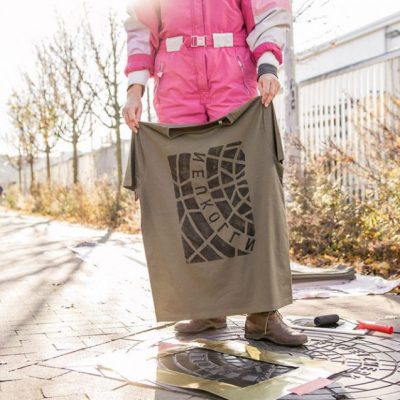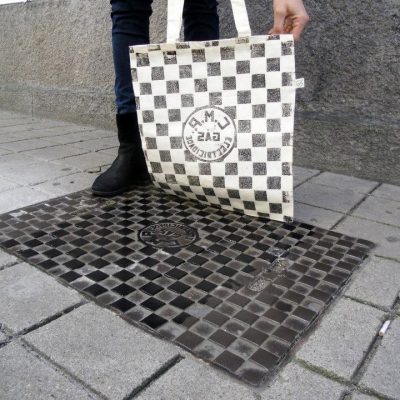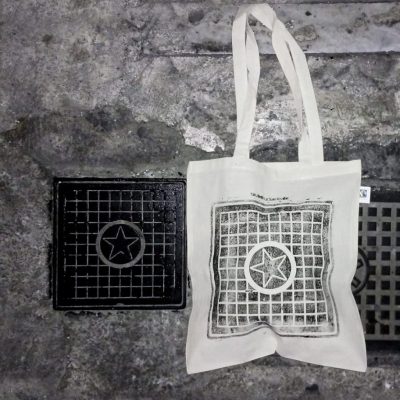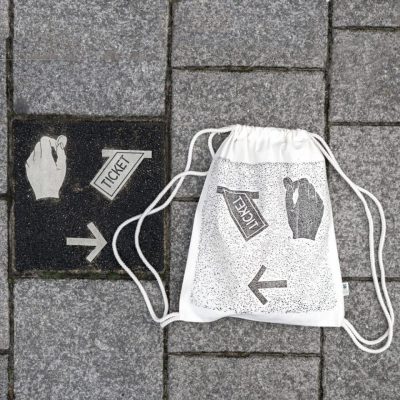Walking through visually rich cities, it is easy to miss horizontal signage and flattish infrastructure embedded underfoot in streets and sidewalks. Since 2006, though, Raubdruckerin (German for ‘Thief Presser’ or ‘Pirate Printer’) has been painting and pressing cloth to such unnoticed objects and lifting their designs. This process has created a growing line of unique guerrilla apparel derived from manhole covers, utility grates, bike lane markings and more.
“The main focus is to explore the surfaces of cities,” says founder Emma-France Raff, “searching for overlooked, seemingly insignificant details on the pavement, which turn out to be true urban design pieces.” The resulting prints “reveal unobserved parts of cities, that are full of history, diversity and creativity.” She sees “the process of converting a detail of the city into an image, displayed on somebody’s chest, as [a kind of] reversed street art,” or literal form of a streetwear.
Her relief printing process works with most public objects that feature differences in depth, like grates with holes or manhole covers with raised lettering. A layer of eco-friendly (water-based) paint is applied to a selected object and a bag or shirt is pressed to its surface.

This activity becomes a kind of street performance as well — “It allows [passersby] to become viewers, observing the process as it evolves. It creates possibilities for communication, exchange and spontaneity.”
Raubdruckerin’s founder got the project off the ground while living in Portugal. She developed the approach together with her father, a painter named Johannes Kohlrusch, in his studio in rural Alentejo. Her “first experiments took place on a road towards Lisbon and after seeing the results, the journey began” — and that journey continues.
Now based out of Berlin, Raubdruckerin recently embarked on a European tour of cities including Barcelona, Madrid, Lisbon, Paris and Brussels. Raff also hope to visit Japan in the near future, famous for its intricate and artistic manhole cover designs. For now, streetwear from Berlin, Amsterdam, Lisbon and Paris is available in their shop.













Comments (7)
Share
This brings up some interesting issues about design ownership. Does the city own the manhole designs or does the company that designed them. If it is the latter, is this a completely unique reuse or copyright infringement?
I’m sure that would depend entirely on locale, but to the best of my memory, here in the US it would be okay for one-off use, so if I make one for me or to give (or possibly even sell), that would be okay, but I couldn’t make a bunch all the same and sell them.
this bothers me. These designs serve a utilitarian purpose and have become part of the urban landscape. Are they overlooked or are they unnoticed? There is a distinction. The artist claims she is doing a service to the city by highlighting these design elements on tshirts and tote bags. I think that only diminishes them. And to profit off of them? As an art enthusiast I find it kind of gross, and as a designer I find it insulting.
How is this any different then selling photos of landmarks?
If they are unnoticed, then it is art by drawing the viewer’s attention to that which was… well 99% invisible, much like Duchamp’ fountain does.
If the ink is water-based, does that means it washes out? I would like to know more about the process.
Me too. I would actually like to capture my own souvenir this way.
I’d like to see the artist take the process a few steps further by replicating the image so the type faces forward and readable.